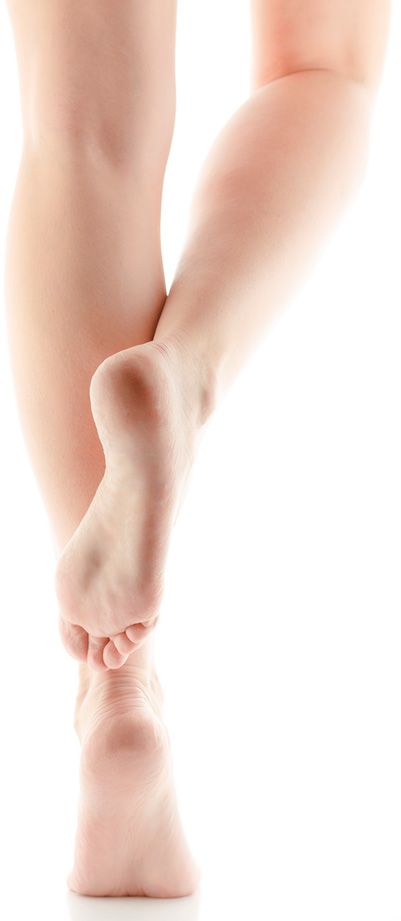Calf Raises | How To Shape Up Your Legs Without Pain
Calf raises are a relatively simple exercise with important benefits when you walk, run, or climb. That’s why it’s so important to learn how do them without hurting yourself. They’ve very beneficial for improving and maintaining your balance, which can help you avoid injuries from falling.
There are many benefits to shaping up your legs.
“Not only will you look better in skirts and shorts,” smiles exercise educator Jamie Costello, “you’ll also find that you walk with more power, agility, and confidence. Plus, the exercise improves blood circulation in your legs.

“What’s more, calf raises train your body to maintain balance to avoid falling.”
How To Shape Up Your Legs Without Pain
Begin by watching and listening to the Pritikin video.
Then, imitate what you see on screen. It helps to watch yourself in a mirror to see if your form and movement match those of Pritikin’s exercise trainers in the video.
Slowly and deliberately, lift off your heels and up onto your toes, pausing at the top before you slowly come down.
Start Out Conservatively
To avoid developing aches or cramps in your calves, begin by doing only 5 to 6 repetitions. And start out with just 1 set.
Then, over the next 4 to 6 weeks, gradually increase to 8 to 12 repetitions, and increase to 2 sets per session. Do 2 to 3 sessions per week, but always give your body 48 to 72 hours between sessions to recover.
Also, it’s a good idea to reserve strength training exercises like calf raises for days of the week when you’re not doing high intensity aerobic training like treadmill intervals.
“We always advise our guests at Pritikin to do their strength training on days when their aerobic activity is moderate or steady-state, for example, walking at 3 to 4 miles per hour with no uphill activity or any other increase in intensity,” recommends Pritikin exercise physiologist Jamie Costello.
How To Shape Up Your Legs Without Injury
To avoid the possibility of falling while doing calf raises, it’s best to use one of your arms to help support yourself. Balance yourself against something like a wall, back of a sofa, or top of a chest of drawers.

Improving Your Performance
If you find that you’re up to 15 repetitions, and doing them easily, you can advance to the more challenging version of calf raises, as demonstrated in the video. With your hand on a supporting wall, do five calf raises on one leg only. Then do five more on the other leg.
Summing Up | How To Shape Up Your Legs Without Pain
Calf raises are a relatively simple exercise with important benefits when you walk, run, or climb. That’s why it’s so important to learn how do them without hurting yourself. They’ve very beneficial for improving and maintaining your balance, which can help you avoid injuries from falling.
And certainly, who wouldn’t like to have nicer looking legs?
Strength Exercises | Key Benefits, Recommendations
We tend to know the benefits of cardiovascular exercises like jogging or swimming. They improve heart function and circulation. They also help lower blood pressure and reduce risk of obesity, diabetes, and heart disease.
But many of us don’t fully understand, or appreciate, the benefits of strength (also called resistance) exercises such as calf raises.
Strength exercises are exercises that strengthen all the major muscle groups of the body. If you do them regularly, you’ll reap huge benefits:
- You’ll feel your muscles grow firmer and more powerful as your endurance increases.
- Your coordination, agility, and balance improve.
- You can better perform a myriad of daily activities – like climbing stairs, getting in and out of your car, carrying groceries, playing golf, hiking the countryside, and rough-housing with the kids. You do them all with greater ease, confidence, and joy.
- As you increase strength and agility, you reduce the chance of falls and injuries.
- You improve your body composition. That’s because as you build lean muscle, you reduce body fat. As you lower your percentage of body fat, you lower your risk of heart disease, obesity, diabetes, and even some forms of cancer.
- Finally, strength training helps build strong bones, even in those with osteoporosis.
Along with all the above, you’ll also look and feel better. There’ll be more pep in your step.
“And your body—from calves and thighs to butt and stomach to chest and arms—will definitely look fitter and trimmer,” encourages Pritikin’s Exercise Director Jamie Costello.
“But the key to all these benefits is not just doing strength exercises, but doing them right. If done incorrectly, they could create pain and keep you from exercising. They might even cause injury, which would also put you on the sidelines,” cautions Jamie.
To accentuate the positive benefits and eliminate the negatives, “we focus on one-on-one guidance here at our Pritikin fitness camp,” says Jamie. “Within a week or two, our guests are noticing that their muscles are automatically falling into correct form, and they’re feeling the benefits.”
Pritikin Basic 8
In addition to calf raises, there are 7 other exercises that are part of the Pritikin Video Series for strengthening the body’s major muscle groups.
| All 8 are: |
| 1. Squat: When done correctly, the squat exercise not only helps you look better (who doesn’t want a nicer-looking butt?), it makes life better. That’s because squatting is a movement we use in all sorts of everyday activities. Watch the How To Do Squats Without Knee Pain video » |
| 2. Calf Raise: Calf raises are a great exercise for toning up legs. What’s more, calf raises train your body to maintain balance, which can help you avoid nasty falls. |
| 3. Chest Press: The chest press not only tones your chest, shoulders, and arms, it strengthens your core. But it’s really important to do the chest press correctly to avoid pain and injury. Watch the Chest Press Video: Tone Your Upper Body Without Pain or Injury » |
| 4. One Arm Dumbbell Row: This exercise builds a strong back. It also strengthens your shoulders, upper arms, and core. You’ll be able to walk and stand longer – at football games, at museums – without having to contend with an aching back. Watch the One Arm Dumbbell Row Video: Strengthen Your Back Without Pain or Injury » |
| 5. 45-Degree Shoulder Raise: The 45-degree shoulder raise can power up your shoulder muscles. You’ll be able to do a lot of things more easily, like lifting your carry-on into the overhead bins of planes. Watch the 45-Degree Shoulder Raise Video: Powerful Shoulders without Pain |
| 6. Reverse Fly – Scapula Retraction: The scapula retraction is a great exercise for improving your posture. The exercise experts at Pritikin recommend using bands. Essentially, you’re moving your shoulder blades (scapula) back toward your spine. Watch the Scapula Retraction Video: Reverse Fly | Build Good Posture and Strong Shoulders Without Pain » |
| 7. Standard Crunch: Here’s an important exercise for your core. Your Pritikin video will show you how to start with the simplest and safest movements, and from there progress to more challenging forms. Watch the Standard Crunch Video: How To Do Crunches Without Hurting Yourself » |
| 8. Prone Leg Lift: The prone leg lift is a superb all-purpose exercise for your lower body. It strengthens the lower back, glutes (the three muscles that make up the buttocks), hamstrings, and core. Watch the Video: How To Do Prone Leg Lifts Correctly » |
At the Pritikin Longevity Center, the #1 priority is performing every type of exercise correctly to avoid pain and injury.